
* In the postwar period, a number of American inventors focused on emerging helicopter technology, establishing a number of rival families of rotorcraft. Among these inventors was Charles Kaman, who focused on side-by-side "eggbeater" rotor helicopters. The family of eggbeaters led to the well-known "Huskie" helicopter; with Kaman also developing a helicopter of conventional main-tail rotor configuration, the "Seasprite"; and then, in the modern day, reverting to the eggbeater configuration with a compact "flying crane" helicopter, the "K-MAX". This document provides a history and description of the Kaman helicopters. A list of illustration credits is included at the end.
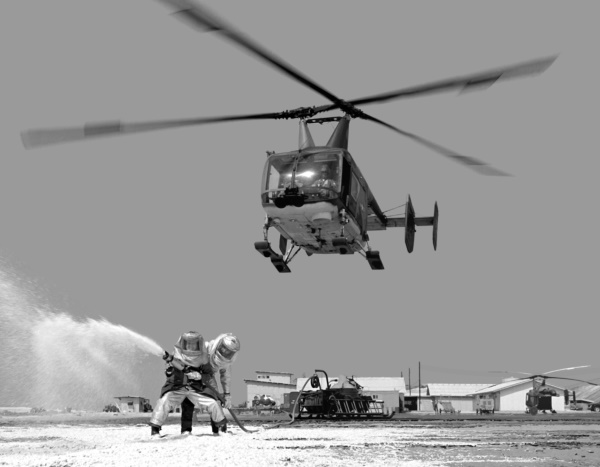
* Charles Kaman founded Kaman Helicopters in Bloomfield, Connecticut, in 1945. He focused on the "eggbeater" helicopter configuration, originally devised by Anton Flettner of Germany. The stereotypical configuration of a modern helicopter is a machine with a main rotor, plus a tail rotor to cancel torque. The eggbeater configuration dispenses with the tail rotor, instead using twin two-blade contra-rotating rotors in a side-by-side, intermeshing configuration; the scheme provides a more compact footprint.
The rotor assemblies were tilted to the sides, meaning the machine was most safely approached from front or rear when the rotors were turning; the rotor masts were supported by open frames. The rotors were made of laminated wood, and featured a gimmick known as a "servo flap" -- which was a small airfoil about three-quarters of the way out on each side a rotor that was actuated to change rotor pitch. It replaced the cyclic rotor control used on other helicopters for directional control. The powerplant was a Lycoming O-435-2 flat-six air-cooled engine mounted behind the rotors in the airframe, providing 170 kW (225 HP). There was a one-piece tailfin.
Kaman's first helicopter was the "K-125", which was a purely experimental machine, being an open airframe -- which made it easier to modify. Initial flight was on 15 January 1947. It was followed by the improved "K-190" and then "K-225" in 1949; the US Navy, Air Force, and Coast Guard respectively bought two, one, and one K-225s for evaluation, the USAF designating the type the "YH-22". One K-225 was fitted with a Boeing 502 (YT50) turboshaft engine with 140 kW (190 ESHP) in 1951, to become the first turbine-powered helicopter.
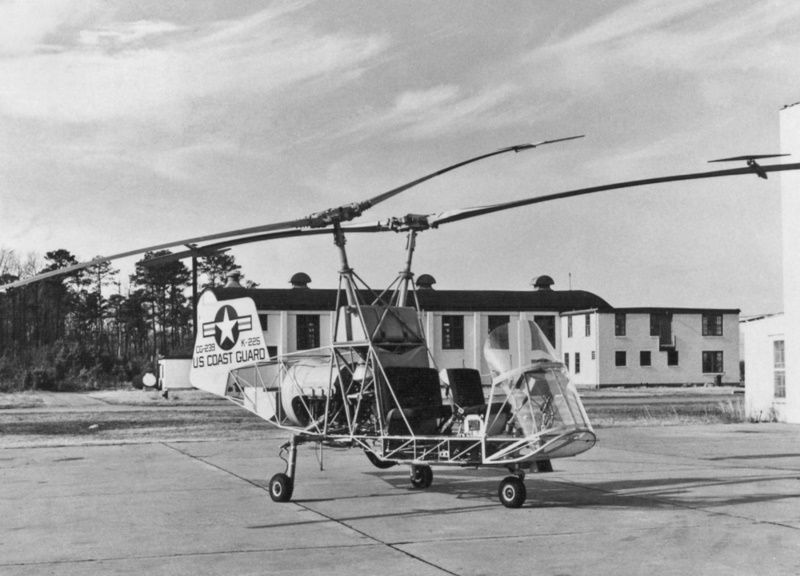
The K-225 was followed by a production model, sold to the Navy for the training role. Two "XHTK-1" prototypes -- "H" for "helicopter", "T" for "trainer", "K" for "Kaman", retaining the "K-225" company model number -- were made, followed by 29 production "HTK-1 / Model K-240" machines, with deliveries from 1951 to 1953. The Coast Guard also obtained a single "XHTK-1G" prototype, but did not buy any production machines. The HTK-1 featured:
The tail issue is one of the puzzles about the first series of Kaman eggbeaters: there were various changes in configuration, and it's hard to figure out if they were changes from prototypes to production machines, or changes from early to later production, and possibly retrofitted to early production.
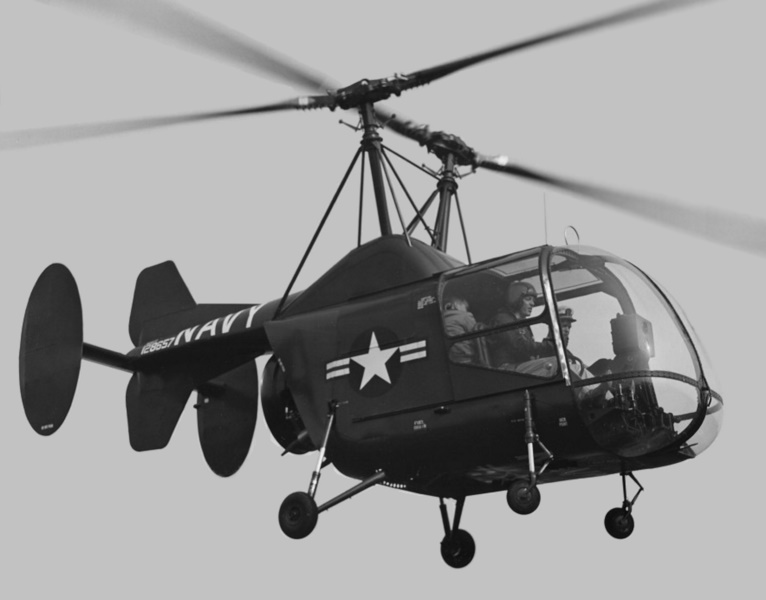
Although the HTK-1 was acquired for the training role -- it had dual controls -- it was also used in the utility role. It was said to be very easy to fly, some sources claiming that it was too easy to fly, too toylike, to be a very good trainer. One HTK-1 was fitted with twin Boeing 502 turboshafts, flying in 1954 to become the first twin-turbine helicopter.
Kaman used the HTK-1 as a basis for radio-controlled drone experiments, beginning with an open-frame version of the HTK-1, with some features of the K-225. After static testing, the "HTK-1K" drone -- painted yellow, and so known as the "Yellow Peril" -- performed its initial flight in 1953, to then be demonstrated to representatives of the Navy, Marines, and Army. In 1955, the Navy and Army jointly awarded Kaman a contract for conversion of three HTK-1s as drones.
They were evaluated into the early 1960s. In an eccentric experiment, one was fitted with electric propulsion, with power fed from ground over a cable. The drone HTK-1s led to the Gyrodyne "Drone Antisubmarine Helicopter (DASH)", a small coaxial-rotor helicopter drone that could carry two homing torpedoes. It was used in service during the 1960s, if with no great success.
* The HTK-1 led to an improved version, with the company designation of "Model 600-K", for the US Marines, Two "XHOK-1" prototypes leading to 81 production "HOK-1" machines, with the "O" standing for "observation".
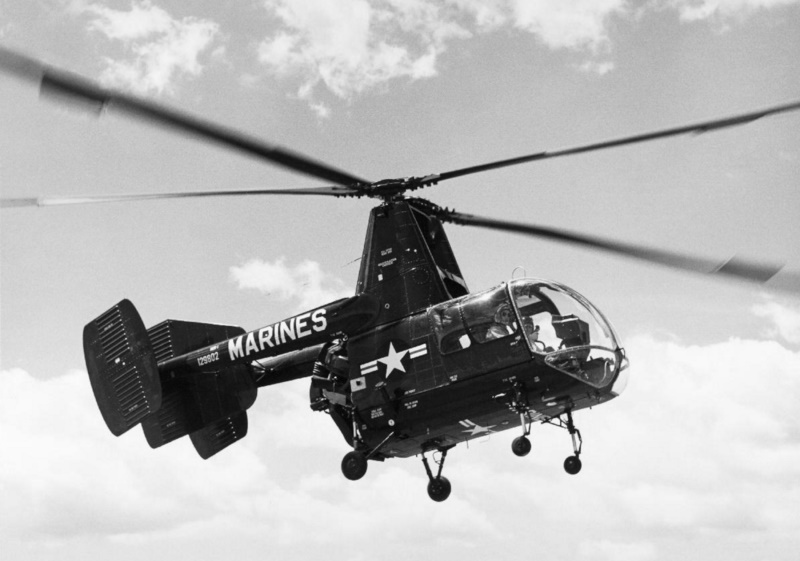
The HOK-1 looked much like the HTK-1, but with a number of distinctive differences:
The Marines used them for observation and scouting, with the type apparently seeing limited service in the Korean War. One HOK-1 was fitted with a Lycoming XT53 turboshaft for trials, which would prove useful for later development of the series. The US Navy obtained 24 "HUK-1" machines, the "U" standing for "utility", generally similar to the HOK-1, except for fit of an uprated R-1340-52 Wasp radial.
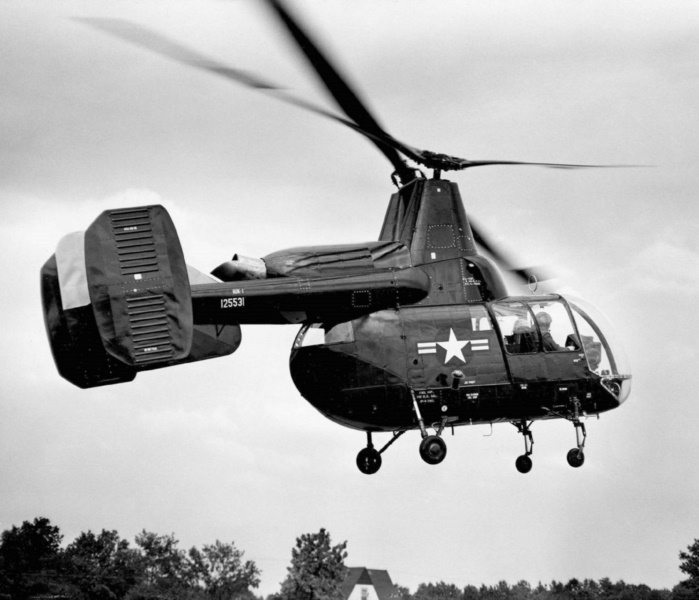
The Air Force obtained 18 "H-43A Huskie" machines in 1958 and 1959, as aircraft crash fire-fighters. They retained the R-1340-48 engine but differed in the tail arrangement, having four tailfins: the endplate fins of the HOK-1, plus a rectangular fin extending above and below the end of each tailboom. Some of the H-43s were fitted with rear clamshell doors over the Wasp engine. Total number of these first-generation Kaman eggbeaters produced -- including experimentals and prototypes -- was 158 machines, including:
Some sources give slightly different numbers. In 1962, the US military acquired a common designation system, with survivors of the first generation of Kaman eggbeaters redesignated as follows:
Although the service history of these machines is very obscure, it appears that by that time they were largely out of service. A few survive as museum displays, but none are flying any longer.
BACK_TO_TOP* The Air Force H-43A led to a substantially redesigned derivative, the "K600-3" or "H-43B" -- from 1962, "HH-43B" -- which was powered by a Lycoming T53-L-1B turboshaft with 615 kW (825 SHP). As with the HOK-1 turboshaft testbed, the engine was placed on top of the fuselage; the fuselage was enlarged, given rear clamshell doors, and could carry eight passengers.
The paw plates were standard fit. The HH-43B retained the four tailfins of the H-43A, though the inner tailfins were eventually rethought and enlarged. The engine exhaust right over the top of the rear doors proving hazardous, an exhaust duct extending to the end of the tail was later added. Its boxy configuration meant it was often compared to a "flying toaster".
Initial flight of the H-43B prototype was on 13 December 1958. The number built varies between sources; Kaman's own memoirs give the quantity as 202, with other sources giving larger quantities. The H-43B had been obtained as a crash fire-fighter -- something of a "flying fire truck", carrying a fire-fighting module, a "fire suppression kit (FSK)", loaded with foam as a sling payload, with the crew including pilot, copilot, two fire-fighters, and a medic.
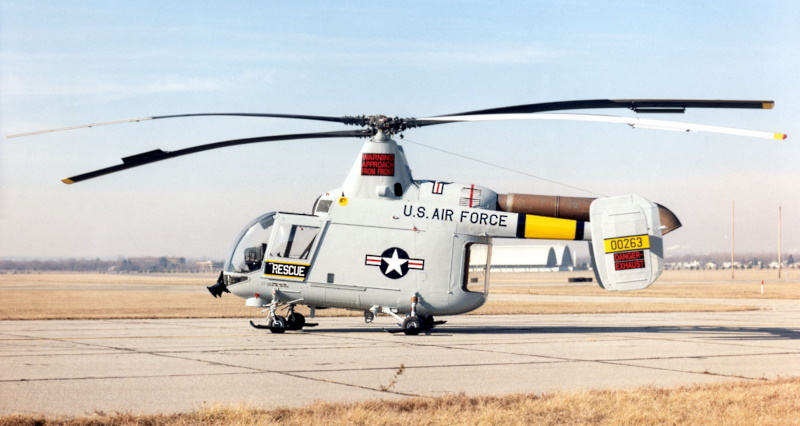
The idea was to get to the crash as fast as possible, with the fire-fighters using foam from the FSK to try to suppress the fire, the HH-43B helping to blow the flames away from the fire-fighters. The objective was to rescue crash survivors, with ground fire trucks then arriving to provide more muscle to the effort. The Huskie also served in the utility, medical evacuation, and combat search and rescue (CSAR) roles in Vietnam -- though it only flew in South Vietnam, lacking the range to go too far afield. CSAR Huskies had the radio callsign PEDRO, and were painted in disruptive jungle camouflage.
___________________________________________________________________
KAMAN HH-43C HUSKIE:
___________________________________________________________________
rotor diameter:
14.32 meters (47 feet)
fuselage length:
7.67 meters (25 feet 2 inches)
footprint length:
14.32 meters (47 feet)
height (rotor heads):
4.73 meters (15 feet 6 inches)
empty weight:
2,095 kilograms (4,610 pounds)
max operating weight:
4,210 kilograms (9,281 pounds)
maximum speed:
195 KPH (120 MPH / 105 KT)
service ceiling:
7,010 meters (25,000 feet)
hover ceiling (in ground effect, max payload):
2,440 meters (8,000 feet)
range:
810 kilometers (500 MI / 435 NMI)
___________________________________________________________________
The HH-43B was followed by the "HH-43F" machines, featuring a T52-L-11A turboshaft -- same power ratings as before, but with better "hot and high" capability -- plus armor. According to Kaman, 37 were built, with a number of HH-43Bs updated to the same spec.
Huskies were provided to US allies under the US Military Assistance Program, including Burma (12), Colombia (6), Iran (17), Morocco (4), Pakistan (6), and Thailand (3). These quantities are uncertain; it is also unclear how many were new-build machines, and how many were hand-me-downs from USAF stock. The USAF retired their Huskies in the early 1970s; a number of machines retired from military service ended up in civilian hands, some being used for logging. A number survive on static display, while at least one is still flying as an airshow demonstrator.
* Working from the Huskie, in 1962 Kaman flew a prototype of a commercial "heli-liner" helicopter, the "Kaman K-1125" AKA "Huskie III". It was obviously derived from the K-600 series, but differed not only in having a remodeled fuselage, but also a single tailboom, and twin engines -- originally Boeing YT60 turboshafts, later Pratt & Whitney PT6B-11 turboshafts. If the Huskie looked like a flying toaster, the K-1125 looked like a flying ice-cream truck. The USAF evaluated it, but nobody wanted to buy it, and it never went beyond the one prototype.
BACK_TO_TOP* While the Kaman company was rolling out the H-43B for the USAF, the company was also working on a helicopter in response to a 1956 US Navy request for proposals, the requirement being for a compact multi-role helicopter capable of operations off smaller vessels.
Kaman submitted its "K-20" design for the competition. The Kaman submission won, with the Navy placing an order for four "YHU2K-1" evaluation machines and 12 "HU2K-1" production machines. Development was protracted, it appears because the Navy waffled on the machine's configuration, with the "Seasprite", as it was named, finally going into Navy service in 1962, being redesignated "UH-2A" with the tri-service name change.
The Seasprite was of generally conventional helicopter configuration, with a four-blade main rotor, and a three-blade tail rotor, mounted on the left of the tailfin, with a braced tailplane low on the tailfin. It was only unusual in using the servo flap scheme instead of cyclic control. The rotor blades had an aluminum core, covered with fiberglass. The main rotor blades could be manually folded.
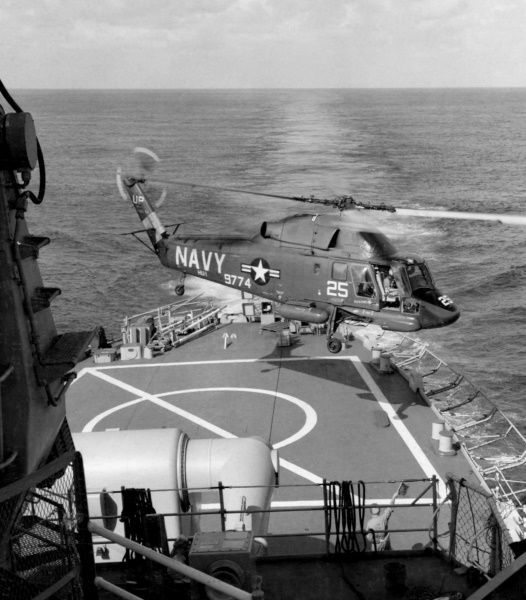
The powerplant was a single General Electric T58-GE-8B turboshaft with a max power rating of 930 kW (1,250 SHP) -- the four evaluation machines had a GE T58-GE-6 engine, with the same power rating. Internal fuel capacity was 1,045 liters (276 US gallons). There was a rear-sliding door on each side of the cockpit, with the door on the right side long enough to permit entry to the crew cabin, and a rear-sliding cargo door on the left.
The UH-2A had a fixed tailwheel and retractable main gear, each main gear having a single wheel and semi-retracting forward into a "cheek" fairing along the side of the cockpit. An external fuel tank with a capacity of 439 liters (116 US gallons) could be carried on an attachment on each side of the fuselage. 88 UH-2As were built in all, followed by 102 "UH-2B" machines, -- which were identical, except for a trimmed-down avionics suite. They were later brought up to a full avionics suite, suggesting budgeting games at work, and in any case ended up being indistinguishable from UH-2As.
___________________________________________________________________
KAMAN UH-2A SEASPRITE:
___________________________________________________________________
main rotor diameter:
13.41 meters (44 feet)
tail rotor diameter:
2.44 meters (8 feet)
fuselage length:
11.48 meters (37 feet 8 inches)
footprint length:
15.9 meters (52 feet 2 inches)
height (rotor head):
4.12 meters (13 feet 6 inches)
empty weight:
2,820 kilograms (6,215 pounds)
max weight with load:
4,535 kilograms (10,000 pounds)
maximum speed:
260 KPH (160 MPH / 140 KT)
cruise speed:
245 KPH (150 MPH / 130 KT)
service ceiling:
5,300 meters (17,400 feet)
hover ceiling (in ground effect)
2,650 meters (8,700 feet)
hover ceiling (out of ground effect):
1,555 meters (5,100 feet)
range (max fuel):
1,080 kilometers (670 MI / 580 NMI)
___________________________________________________________________
They were employed in utility, search and rescue (SAR), and -- flying off of aircraft carriers -- in the "plane guard" role, fishing aircrew out of the water if their plane went into the drink. The UH-2A/B saw action in the Vietnam War, some being used in the CSAR role, being armed with a 7.62-millimeter M60 machine gun on a flexible mount on both sides. On the night of 18-19 June 1968, a CSAR UH-2A operating off the guided missile frigate USS PREBLE and under the command of Lieutenant JG Clyde Lassen performing a daring night rescue of two F-4 Phantom crew that had been shot down over North Vietnam, Lassen receiving the Congressional Medal of Honor for his determination to continue the rescue operation under highly adverse conditions.
* In 1963, the US Army began work on a helicopter gunship, which would eventually emerge as the Lockheed AH-56 Cheyenne. The AH-56 program was going to take time, and so the Army also wanted to obtain an interim attack helicopter, based on an existing helicopter type. The Kaman entry in the competition was the "H-2 Tomahawk", a modified UH-2A. It featured twin chin turrets, both with two M60 machine guns, for a total of four machine guns; the turrets could be independently targeted, or slaved to fire on a single target. The H-2 could also be fitted with a flexibly-mounted door gun. It had stub wings on each side of the fuselage, each wing capable of handling two stores -- such as an external fuel tank, or a 7-round 70-millimeter unguided rocket launcher.
The Army was favorably impressed with the H-2 and wanted to obtain production quantities, but changes in policy meant it didn't happen. The Army would, after some rethinking of the effort, obtain the Bell AH-1 Cobra gunship as the interim gunship instead, the Cobra proving highly successful. Ironically, although the AH-56 was flown and evaluated, it would never enter production, with the Cobra becoming a US mainstay.
In 1964, one UH-2A was modified as a high-speed "compound helicopter" testbed, the "YUH-2" under a joint Army-Navy program, being fitted with GE YJ85 turbojet on a pylon on the right side of the fuselage, the turbojet providing 11.1 kN (1,130 kgp / 2,490 lbf). The main difficulty with trying to boost speed on a helicopter is that the rotor is moving forward on one side of the fuselage and moving backward on the other, which results in an enhanced tendency for the rotorcraft to flip over as speed is increased.
In early 1965, the YUH-2 was fitted with short wings, which offloaded the rotor at high speeds. The YUH-2 had a maximum speed of 360 KPH (225 MPH / 195 KT). The YUH-2 was purely experimental, there being no intent to put the configuration into production, with the machine reverting to UH-2A configuration in 1966.
* In service, the UH-2A/B was seen as underpowered, and so all the survivors were extensively modified to be fitted with twin T58-GE-8B turboshafts, resulting in a set of new variants:
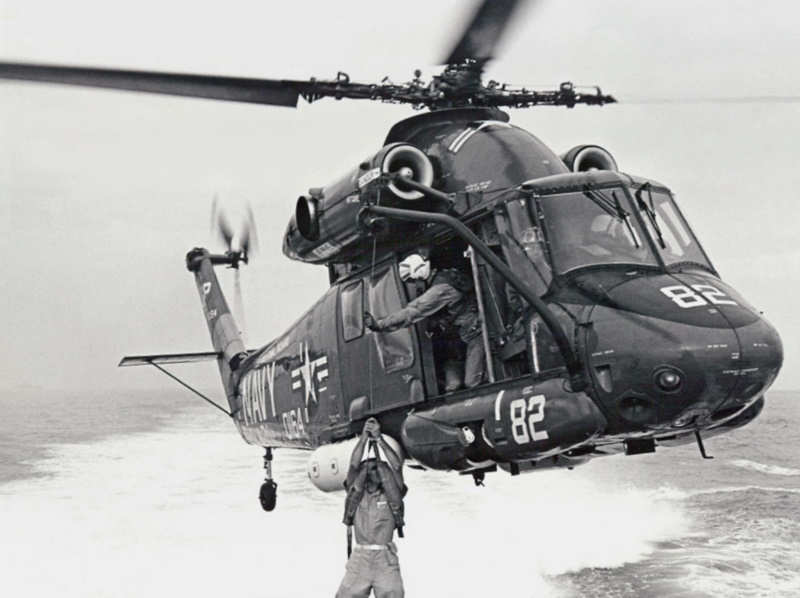
The SH-2D was intended to serve as the "Light Airborne Multi-purpose System (LAMPS)". It featured:
Normal crew was three, including pilot, co-pilot, and sensor systems operator. The "multi-purpose" element of the LAMPS name is a bit confusing, since on the face of it, it was an optimized ASW helicopter. However, it appears it could be fitted with a rescue hoist for SAR operations, had a belly sling cargo hook, and some of the ASW systems may have been removeable, to permit internal cargo or personnel carriage. Initial deployments of the SH-2D were in 1971.
In 1972, two "YSH-2E" evaluation machines were flown as pathfinders for a "LAMPS Mk.II" effort, with AN/APS-112 radar and new avionics. That configuration didn't go into service, being leapfrogged by a "LAMPS Mk.III" configuration, which emerged as the "SH-2F". The general configuration was like that of the SH-2D, the two variants being hard to tell apart, but the SH-2F had significant improvements:
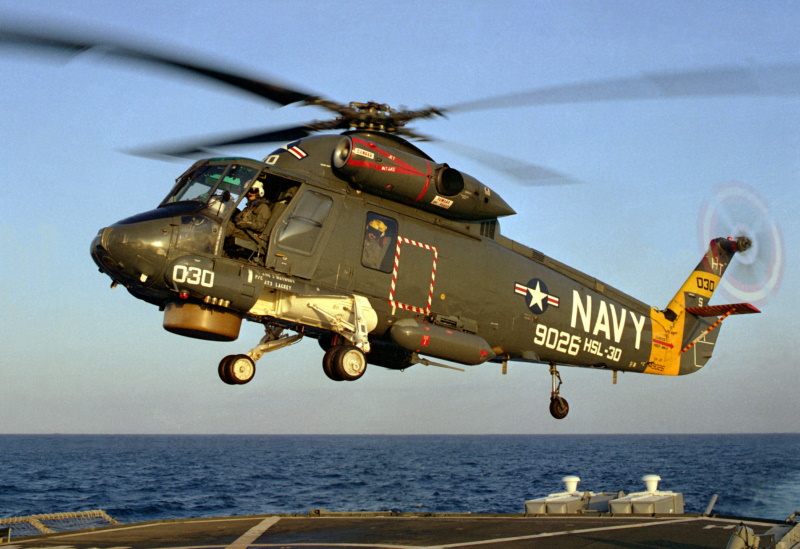
Engines were T58-GE-8F turboshafts, with 1,005 kW (1,350 SHP) each. Fuel capacity, with twin 455-liter (120 US gallon) external tanks, was 1,499 liters (396 US gallons). The nose was split, with the two sides hinging back for access to systems and to reduce deck footprint.
___________________________________________________________________
KAMAN UH-2F SEASPRITE:
___________________________________________________________________
main rotor diameter:
13.41 meters (44 feet)
tail rotor diameter:
2.49 meters (8 feet 2 inches)
fuselage length:
11.68 meters (38 feet 4 inches)
footprint length (nose panels folded):
16.03 meters (52 feet 7 inches)
height (rotor head):
4.14 meters (13 feet 7 inches)
empty weight:
3,195 kilograms (7,040 pounds)
normal take-off weight:
5,805 kilograms (12,800 pounds)
maximum speed:
265 KPH (165 MPH / 145 KT)
cruise speed:
245 KPH (150 MPH / 130 KT)
service ceiling:
6,860 meters (22,500 feet)
hover ceiling (in ground effect):
5,670 meters (18,600 feet)
hover ceiling (out of ground effect):
4,695 meters (15,400 feet)
range (max fuel):
680 kilometers (422 MI / 365 NMI)
___________________________________________________________________
Initial deployment was in 1973. 104 older Seasprites were updated to the SH-2F configuration, with the Kaman production line re-opened in 1982 to produce 60 new-build machines. None of the Seasprites up to the SH-2F were exported -- with a little fine print on that blanket statement, as discussed later.
BACK_TO_TOP* From 1983, the US Navy began to obtain the Sikorsky S-70B Seahawk, which would become the service's workhorse helicopter. It might have seemed that the Seasprite's days were numbered, but an effort to update it was nonetheless begun in 1985. A modernized Seasprite was seen as an effective weapons platform; in addition, the Seahawk could not operate off KNOX-class and early PERRY-class frigates.
The biggest change was to fit the Seasprite with more powerful General Electric T700-GE-401/401C turboshafts, with the prototype "YSH-2G Super Seasprite" performing its initial flight on 2 April 1985. The Super Seasprite had airframe modifications to support the substantially bigger and more powerful engines, giving it a "beefier" look than early Seasprites, and also had a composite rotor. Avionics were generally updated.
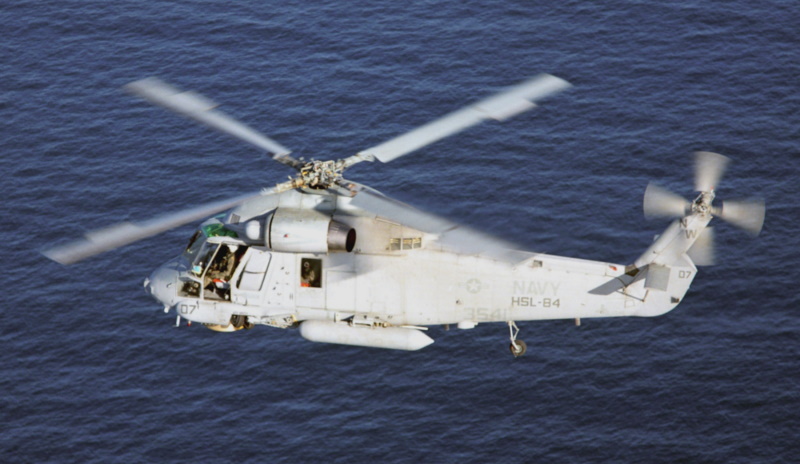
The Super Seasprite program appears to have been a low priority, since the "SH-2G" wasn't introduced to service until 1993. The US Navy obtained 24, with six built new, and 18 built by upgrade from SH-2Fs, all going into service with the US Naval Reserve. From 1996, Super Seasprites were able to carry the "Airborne Mine Counter Measures (AMCM)", with the Kaman "Magic Lantern" laser mine detection system. The last US Navy Super Seasprites were retired from the Naval Reserve in 2003.
___________________________________________________________________
KAMAN SH-2G SUPER SEASPRITE:
___________________________________________________________________
main rotor diameter:
13.51 meters (44 feet 4 inches)
tail rotor diameter:
2.46 meters (8 feet 1 inch)
fuselage length:
12.19 meters (40 feet)
footprint length:
16.08 meters (52 feet 9 inches)
height (tail rotor):
4.58 meters (15 feet)
empty weight:
3,485 kilograms (7,680 pounds)
max weight with load:
6,305 kilograms (13,900 pounds)
maximum speed:
270 KPH (170 MPH / 145 KT)
cruise speed:
220 KPH (140 MPH / 120 KT)
service ceiling:
6,400 meters (21,000 feet)
hover ceiling (in ground effect):
5,670 meters (18,600 feet)
hover ceiling (out of ground effect):
4,755 meters (15,600 feet)
ferry range (with three external tanks):
1,040 kilometers (645 MI / 560 NMI)
___________________________________________________________________
* The Super Seasprite was also adopted by several foreign air arms. In 1995, Egypt signed a contract for ten SH-2Gs for use by the Egyptian Navy, these machines being updates of retired USN SH-2Fs. The Egyptian machines were similar in configuration to US Navy Super Seasprites, carrying gear for antisubmarine warfare. The Egyptians also obtained a number of SH-2Fs as spares hulks.
Both Australia and New Zealand decided to obtain the Super Seasprite in 1997, with the exercise taking widely differing directions in the two countries. The Royal Australian Navy was obtaining the Sikorsky Seahawk, but wanted a smaller helicopter to operate off ANZAC-class frigates and an "offshore patrol vessel (OPV)", planned in conjunction with Malaysia. Australia signed a contract for 11 Super Seasprites, to be rebuilt from mothballed SH-2F airframes.
The Australians specified an ambitious and largely new avionics system, with the "SH-2G(A)" ending up substantially different from any other Super Seasprites. The effort went too far; by 2005, it was clearly in trouble, though the government persisted in trying to get it to work. After the election of a new government, the SH-2G(A) was finally canceled in 2008. The machines were returned to Kaman.
The New Zealanders had no such troubles. They initially ordered five "SH-2G(NZ)" machines to operate off ANZAC-class frigates, replacing Westland Wasp helicopters. Two ex-USN SH-2Fs were provided as an interim solution until the SH-2G(NZ) machines arrived in 2001-2003, all of these machines being new-build. The SH-2G(NZ)s saw service in East Timor.
The New Zealanders obtained ten of the SH-2G(A) machines, fitted out for New Zealand service, in 2013. These machines, redesignated "SH-2G(I)", replaced the original SH-2G(NZ) machines, with eight going into line service, and two used as spares hulks. The sales deal also included spares, a full-motion simulator system, and Penguin missiles, originally obtained by the Australians.
They featured a "glass cockpit" with four multifunction displays and two data-entry displays, in a night vision goggle-compatible cockpit. Other avionics included a Telephonics AN/APS-143 search radar, a forward-looking infrared imaging turret, a satcom communications link and a Link 11 datalink, a GPS navigation system, plus a defensive countermeasures system. They are still in service, and will be given further updates to keep them flying beyond 2030.
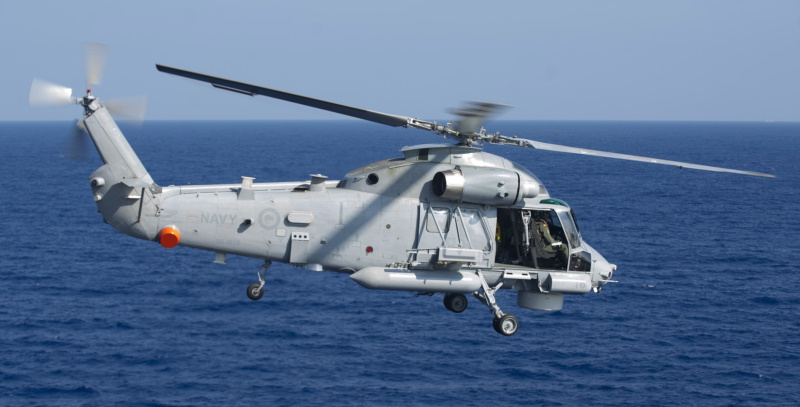
The five original SH-2G(NZ) machines were sold to the Peruvian Navy, being refurbished by General Dynamics. Four ex-USN SH-2Gs were handed to Poland, as part of the purchase of two ex-USN OLIVER HAZARD PERRY-class frigates -- named ORP GENERAL TADEUSZ KOSCIUSZKO and ORP GENERAL KAZIMIERZ PULASKI, Polish adventurers who fought in the American Revolution. The helicopters were fitted with a 7.62-millimeter PK machine gun on a flexible mount.
BACK_TO_TOP* The Kaman company was highly diversified, not only building assemblies for other aerospace firms, but also producing a range of other products, including the Ovation guitar. Following the end of Seasprite production, Kaman didn't produce any flying machines themselves; but in the 1990s, the company got interested in building an "eggbeater" machine for the "flying crane" role. The first flight of a demonstrator was on 23 December 1991, this machine being followed by a more complete prototype in 1994 -- a nonflying static-test machine was built as well. The first production Kaman "K-1200 K-MAX" machine was delivered in that year.
The K-MAX was made primarily of aircraft aluminum alloy. In some ways, it was a direct descendant of the Huskie, having much the same "eggbeater" dynamic system, with the servo flaps; it even had wood rotor blades, with fiberglass skinning, and a Honeywell (Lycoming) T53 turboshaft engine -- the T53-17A-1 variant, with 1,005 kW (1,350 SHP). The K-MAX otherwise didn't look anything like the Huskie, instead featuring a slender fuselage, fixed tricycle landing gear, a tall tailfin, and a tailplane with angled endplates well forward on the tailboom.
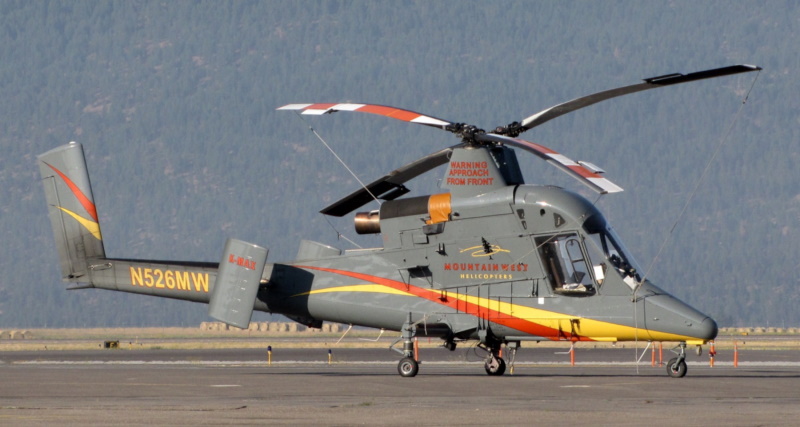
The fuselage angled out from top to bottom; along with bulged side windows, that gave the pilot a better downward view. A nose-mounted rear-view mirror was optional. There was only a single seat, with a cargo hold behind it to allow the pilot to carry personal baggage and other kit. An external seat was later offered, attached forward of the main landing gear assembly. All landing gear had single wheels, the main gear being mounted on arms to give the K-MAX a comfortably wide landing stance.
Electronic systems included an automated flight log to allow the pilot to keep a record of flight operations. Sling loads of up to 2,720 kilograms (6,000 pounds) could be carried. The sling hook could shift back and forth in a slot to ensure load balance in flight, while the rotors could be stowed in a front-back configuration.
___________________________________________________________________
KAMAN K-1200 K-MAX:
___________________________________________________________________
rotor diameter:
14.73 meters (48 feet 4 inches)
fuselage length:
12.73 meters (41 feet 9 inches)
footprint length:
15.58 meters (52 feet)
height (rotor heads):
4.14 meters (13 feet 7 inches)
empty weight:
2,335 kilograms (5,145 pounds)
max weight with load:
5,445 kilograms (12,000 pounds)
maximum speed:
185 KPH (115 MPH / 100 KT)
service ceiling:
4,570 meters (15,000 feet)
hover ceiling (in ground effect, max payload):
2,440 meters (8,000 feet)
range:
555 kilometers (345 MI / 300 NMI)
___________________________________________________________________
Production of the K-MAX ceased in 2003 after manufacture of 38 helicopters, including the static-test prototype. The K-MAX wasn't a failure; it was a specialized product that was never expected to be produced in large numbers. It proved extremely useful in both commercial and military service. The US Navy evaluated in the "vertical replenishment" role, while Lockheed Martin converted a number of K-MAXs to "CQ-24A" drones, with two pioneering drone cargo delivery with the US Marines in Afghanistan from 2011 to 2014. In 33 months of service there, the K-Max helicopters -- designated "CQ-24A" in Marine service -- delivered over 2,000 tonnes (2,200 tons) of cargo.
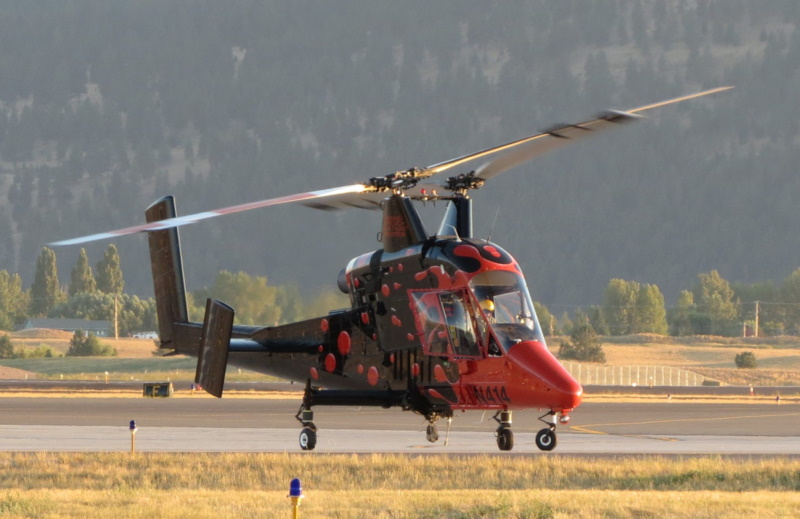
Indeed, the K-MAX proved so useful that Kaman put it back into production in 2016, producing an initial batch of ten machines. Kaman introducing a "Titan" variant in 2021, with improved drone flight capabilities. The Titan system could be retrofitted to older K-MAX machines. However, that was the end of it; sales finally fading out, the K-MAX was taken out of production in 2023, after total production of 60 machines.
The K-MAX had simply outlived its usefulness, interest having moved on to drones. Kaman is now working with partner company Near Earth Autonomy on a "quadcopter" drone named the Kargo for aerial cargo delivery. Initial flight of a prototype was in 2024. It has a combustion powerplant -- with a hybrid-electric system envisioned down the road -- and will be able to haul 365 kilograms (800 pounds) as a sling load, somewhat less in a removeable belly cargo pod. It can fit neatly into a standard shipping container. There is substantial military interest in the Kargo.
BACK_TO_TOP* The Kaman helicopters are not well documented, so this document relied mostly on various volumes of JANE'S ALL THE WORLD'S AIRCRAFT, plus such bits and pieces as I could find from Wikipedia and other internet sources.
* Illustrations details:
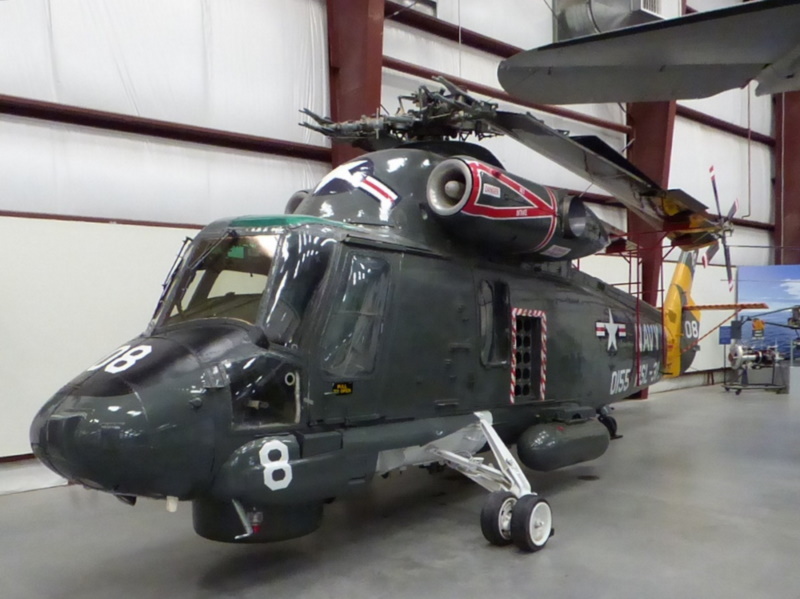
* Revision history:
v1.0.0 / 01 sep 18 v1.0.1 / 01 jul 20 / Illustrations update. v1.0.2 / 01 may 22 / Review & polish. v1.0.3 / 01 apr 24 / Review & polish.BACK_TO_TOP
